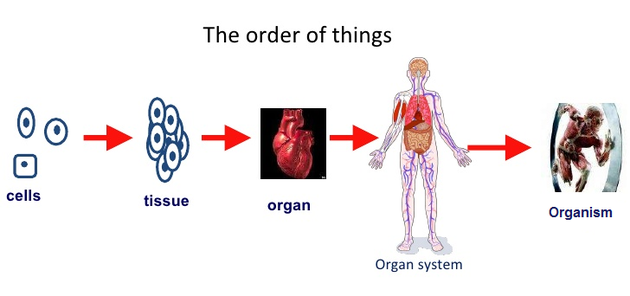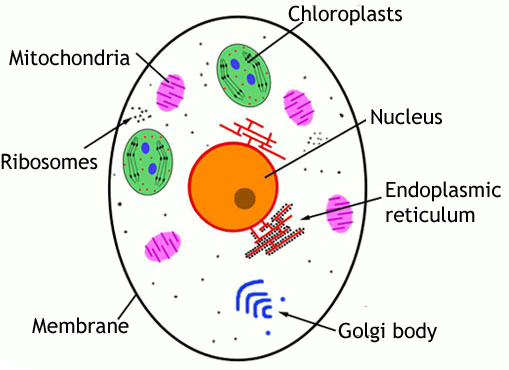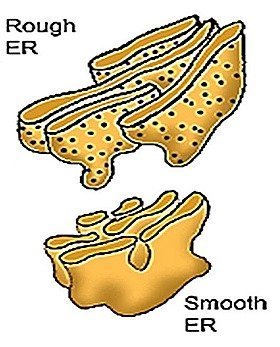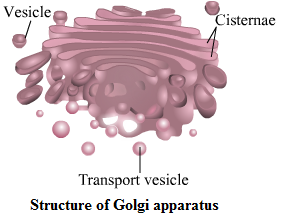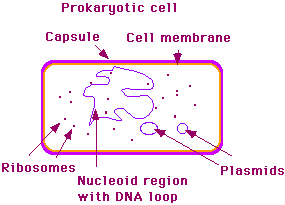Cell Structure
Edited by Jamie (ScienceAid Editor), Taylor (ScienceAid Editor), Sim
Cell Structure
A Cell is defined as the smallest structural and functional unit that constitutes an organism. Each organism is made up of cells. A group of cells join together to form a tissue (example hepatic cells combine to form the liver tissue). These tissues, later on, combine together to form the organs of a body (example, pancreatic tissues combine to form the pancreas). Then, the different organs work together to form a system (for example, the digestive system involves the pancreas, the stomach, the esophagus, the small intestine,...), and finally, the group of systems together form an organism (for example, the circulatory system, the digestive system, the endocrine system, and all the other systems work together to form the body of the organism). See the diagram below.
Two Major Types of Cells
- 1. Eukaryotic cells: are cells that have membrane-bound organelles, like a nucleus, mitochondria, ribosomes, endoplasmic reticulum, and others. These cells are found in plants, animals, fungi,...
- 2. Prokaryotic cells, on the other hand, do not have membrane-bound organelles. They generally have a semi-rigid cell wall and contain one or more DNA loops located in an area called the nucleoid. A typical example of a prokaryotic cell is the bacterium.
1. Eukaryotic Cells
Below is a diagram of a typical eukaryotic cell. Note the different organelles it contains
An organelle is a body within a cell that has a particular function.
Names and functions of different organelles
- 1. The Nucleus
The nucleus is the brain of the cell where the genetic material is stored in the form of DNA. It has a nucleolus where ribosomes are made and is surrounded by the nuclear membrane that is attached to the endoplasmic reticulum.
- 2. The Mitochondrion
Is the organelle which produces energy to the cell and the body in the form of ATP molecules.
For more information See: respiration.
- 3. The Endoplasmic Reticulum
There are two types of endoplasmic reticulum (ER)
- 1. The Rough endoplasmic reticulum (RER) is covered with ribosomes that synthesize proteins, which are then transported by the RER to be used elsewhere in the body.
- 2. The Smooth endoplasmic reticulum (SER) has more tubular sacs and is not covered by ribosomes. It contains enzymes important for the synthesis of fats, lipids, etc.
- 4. The Golgi Body
Also known as the Golgi apparatus. This organelle receives substances from the ER. It then modifies them before secreting them out of the cell via small sacs known as vesicles.
- 5. The Chloroplasts
See photosynthesis for more information.
2. Prokaryotic Cells
They are cells with no membrane-bound organelles. The best example of a prokaryotic cell is a bacterium. In the prokaryotic cells, the specific functions, needed for the survival and the division of the cell, are not carried out by the organelles (like the eukaryotic cells) but performed by other parts of a prokaryotic cell.
For more information about the structure of bacteria see bacteria.
Referencing this Article
If you need to reference this article in your work, you can copy-paste the following depending on your required format:
APA (American Psychological Association)
Cell Structure. (2017). In ScienceAid. Retrieved Apr 19, 2024, from https://scienceaid.net/biology/cell/structure.html
MLA (Modern Language Association) "Cell Structure." ScienceAid, scienceaid.net/biology/cell/structure.html Accessed 19 Apr 2024.
Chicago / Turabian ScienceAid.net. "Cell Structure." Accessed Apr 19, 2024. https://scienceaid.net/biology/cell/structure.html.
If you have problems with any of the steps in this article, please ask a question for more help, or post in the comments section below.
Comments
Article Info
Categories : Cell
Recent edits by: Taylor (ScienceAid Editor), Jamie (ScienceAid Editor)

